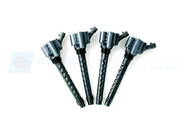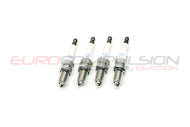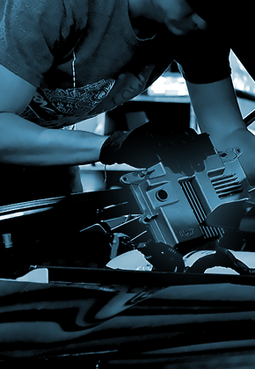
I occasionally hear people say that the 4C isn't an exotic car because it has a small 4 cylinder engine. What I think these people fail to realize is the the 4C's engine is an exotic car engine, it's just scaled down to match the size of the car.
The purpose of this article is to explain to owners and potential owners just how advanced the 4C's engine really is. If you have read part one, which deals with the head and camshaft timing system, great, if not, it's OK to start here, but please read part 1 also which deals with the engine's top end.
Let's get right into it, and start with the block. The block is the main structure of the engine which contains the pistons and crank shaft. In the case of the 4C. It's an aluminum block to save weight and it's fitted with cylinder liners made from GOE300 steel. These liners are integrated into the block and are there to prevent rapid cylinder wear.
So far this is all pretty standard stuff, an aluminum block with steel or cast iron sleeves is pretty common.
THE 4C ENGINE BLOCK:
There is one big factor that sets the 4C's block apart from almost every other production car's engine. It's a two piece block. To help understand why that matters we have to look at some main bearings caps from some other engines.
The engine's crankshaft rotates in the main bearings. The main bearings are secured in place by main bearing caps. A typical engine has a “2 bolt main” meaning 2 bolts per main bearing cap. Let's see what that looks like.
A typical American V8 with a 2 bolt main:

Now a conventional block and 2 bolt main is fine for most applications. However when more performance is needed, manufacturers usually go with either a 4 bolt main or some other block design. For example, back in the muscle car era, if you ordered a Chevy Impala with a small block V8, you normally got a 2 bolt main, however in the Corvette, the engine would usually have a 4 bolt main.
Here is an American V8 with a 4 bolt main, notice only the center 3 caps actually have 4 bolts:

Historically, Alfa Romeo engines use 2 bolt mains, but reinforce that area with a deeper skirt on the block and additional webbing down there, which works very well.
Here is an older Alfa Romeo V6, you can see it has a 2 bolt main but uses a deep block skirt and reinforcements.

The 4C's engine combines both of these concepts into it's 2 piece block. It essentially uses the entire bottom of the block to strengthen the main bearing caps. This is a very unusual, and expensive way to build an engine. Very few engines use this type of construction, other than some Ferraris, I don't know of any.
The 4C's Lower Block. This is essentially a 6 bolt main with a lot of extra structure for strength.

The rest of the 4C's bottom end is built for competition. This includes the pistons, rods, and the crankshaft.
The Pistons:
Someone at Alfa decided to give us really good pistons. As a tuner I am very thankful for that.
The 4C comes equipped with forged pistons that are likely superior to anything in the aftermarket. To reduce friction the pistons are fitted with rings that have a low tangential load and have a graphite coating on the skirt.
The pistons have several design features that allow us to run a lot of boost and timing to get a lot of power. They have a compression ratio of 9.25:1, which is high enough to give us decent off boost power, but low enough to allow us to really turn up the boost.
To help keep the pistons safe from detonation they are cooled by an oil jet. Additionally they have a bowl contained in the crows. The purpose of that bowl is to direct the fuel spray to the spark plug. Not only does this help ward off detonation, it helps with power, fuel economy and emissions.
Crankshaft:
The crankshaft has the job of turning all the up and down motion of the pistons into rotational force.
The 4C's crankshaft is built to handle massive amounts of power. It's a forged steel crankshaft with excellent lubrication and journal sizes that rival most 5 and 6 liter American V8s!
There isn't much more to be said about the crank, but I'll add that Alfa has a long history of making very stout crankshafts, I doubt we will ever see a 4C crankshaft fail due to excessive power.
Connecting Rods: Caution, Oversimplification Ahead
This one is a little complicated to explain. Connecting rods look simple, but connecting rod design can actually be a lifelong study, it's that complex. However, I am going to try and summarize it. In general, the longer the connecting rods the more power you will get. This isn't just my opinion, it's the opinion of Smokey Yunick, and David Vizard. If you don't know who those guys are, google them. It also appears to be the opinion of the engineers at Alfa Romeo because they normally use pretty long connecting rods.
In Alfa's own words they are using a “very long connecting rod”. Just how long is it. Well, it's 148mm from the center of the bearings. For comparison, a typical Chevy 5.7 liter V8 has rods just under 145mm in length.
What this does for us is it adds some power at the bottom end while still allowing for a relatively short stroke crankshaft for power at the high end.
The 4C's connecting rods are not forged, but they don't need to be. To understand why not, we need to look at the way rods tend to fail.
Connecting rods usually fail in one of two ways. If they get too much compressive stress on them, they can bend. Power and torque put a compressive stress on the rods. Alfa used what they call a “double T” design which bascially means that the cross section looks like an “I” beam except that the crosses at the top and bottoms of the I are really long, more like the cross at the top of a T.
This design makes it very difficult to collapse or bend an Alfa rod with power. Normally when you see a rod with this design fail, it's due to either hydrolock, or just an insane amount of power. I can honestly say I have never seen an Alfa rod fail due to compressive stress.
Here is an example of a rod that's been bent due to compressive stress:

Now the other type of connecting rod failure IS a type we have to worry about with Alfa's rods. That's expansion stress. This is the opposite of compressive stress and it occurs when the piston changes direction and tries to pull the rod apart. The primary factor here is engine RPM. As RPM rises, expansion stress goes up a lot. Horsepower and Torque have a relatively minor effect on this. Normally what happens is the big end of the rod opens up, and the rod comes apart. When this happens it's really ugly.
The key here when modifying or tuning the 4C is to keep the expansive stress at a minimum. Viat tuning we will likely never kill a 4C rod with compressive stress, but if we go too crazy raising the rev limiter, we could kill an engine by causing it to throw a rod. So to mitigate this we do two things with our tunes. We keep the rev limiter increases to known safe levels, and we use boost to provide a cushion when the piston reaches the top of the stroke. (the later could be a technical paper all on its own)
This is a great example of an Alfa Rod failing due to expansion.

To protect the crankshaft and rods the engine features a very good oiling system with a large quantity of oil in the sump, a good oil cooler and lots of circulation.
The Best of Everything:
The overall point here is that this is a mini exotic car engine. It has the best of everything, a two piece block, forged pistons, a forged crank, and a good oiling system. Although it's rods are not forged, they are more than up to the task. Combine this with the very advanced VVT system and it's truly an exotic car engine.
The engine is absolutely loafing to make it's rated horsepower. On that subject, I believe it's under rated a little and actually has about 250hp, not 237, but in either case that's nothing for this engine.














